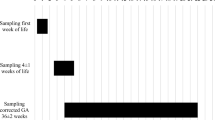Abstract
Children with congenital heart disease need adequate diagnostic classification regarding their cardiovascular status (CVS). N-terminal brain natriuretic peptide (N-BNP) plasma concentration indicates dysfunction of the cardiovascular system and guides decisions concerning treatment and prognosis. Reference values are established for adults, with age-dependent increasing values and higher values in women. To avoid misclassification concerning the CVS, a large group of healthy children and adolescents can be used show the relationship between gender, age, and N-BNP and these can serve as reference values. N-BNP was measured in 434 healthy subjects (240 female and 194 male) with ages ranging from 0 to 32 years without any cardiovascular disease or renal or hepatic impairment. Measurements were performed with an electrochemiluminescence immunoassay from Roche Diagnostics. Mean N-BNP decreased from 12.6 fmol/ml (0–9 years; n = 79) to 9.41 fmol/ml (10–14 years; n = 154) and in adolescents from 6.1 (15–19 years; n = 99) to 4.8 fmol/ml (>19 years; n = 102) in adults (p < 0.05). Mean N-BNP concerning gender did not differ in any age group younger than 19 years. In contrast, the adult female group had 78% higher N-BNP compared to the male group (p < 0.05). There was a significant peak in N-BNP at the age of 12–14 years. This study shows that reference values for N-BNP differed profoundly in children compared to adults and were up to 260% higher in children without any gender difference. Therefore, these reference values will help to avoid CVS misclassification in children for the biomarker N-BNP.


Similar content being viewed by others
References
Ationu A, Singer DR, Smith A, et al. (1993) Studies of cardiopulmonary bypass in children: implications for the regulation of brain natriuretic peptide. Cardiovasc Res 27:1538–1541
Best PJ, Berger PB, Miller VM, Lerman A (1998) The effect of estrogen replacement therapy on plasma nitric oxide and endothelin-1 levels in postmenopausal woman. Ann Int Med 128:285–288
Clerico A, Emdin M (2004) Diagnostic accurancy and prognostic relevance of the measurement of cardiac natriuretic peptides: a review. Clin Chem 50:33–50
Cowie MR, Mendez GF (2002) BNP and congestive heart failure. Prog Card Vasc 44:293–321
Cowley CG, Bradley JD, Shaddy RE (2004) B-type natriuretic peptide levels in congenital heart disease. Pediatr Cardiol 25:336–340
De Bold AJ, Ma KK, Zhang Y, et al. (2001) The physiological and pathophysiological modulation of the endocrine function of the heart. Can J Physiol Pharmacol 79:705–714
Gallagher PE, Lenhart JR, Chappell MC, Brosnihan KB (1999) Estrogen regulation of angiotensin-converting enzyme mRNA. Hypertension 33:323–328
Hunt PJ, Richards AM, Nicholls MG, et al. (1997) Immunoreactive amino-terminal pro-brain natriuretic peptide (NT-PROBNP): a new marker of cardiac impairment. Clin Endocrinol Oxford 47:287–296
International Conference on Harmonisation E9 expert working group. (1994) ICH harmonised tripartite guideline. Statistical principles for clinical trials. Stat Med 18:19.5–1942
Kelly R, Struthers AD (2001) Are natriuretic peptides clinically useful as markers of heart failure ? Ann Clin Biocehm 38: 94–102
Koch A, Singer H (2003) Normal values of B type natriuretic peptide in infants, children, and adolescents, Heart 89:875–878
Kuroski de Bold ML (1999) Estrogen, natriuretic peptides and the renin–angiotensin system, Cardiovasc Res 21:1730–1736
Lainchbury JG, Espiner EA, Nicholls MG (1997) Cardiac hormones: diagnosis and therapeutical potential. N Z Med J 110:219–221
Levin E, Gardner D, Samson W (1998) Natriuretic peptides. N Engl J Med 339:321–327
Maisel A (2001) B-type natriuretic peptide levels; a potential novel “white count” for congestive heart failure. J Card Failure 7:183–193
Maisel A, Krishnaswamy P, Nowak RM, et al (2002) Rapid measurement of B-type natriuretic peptide in the emergency diagnosis of heart failure. N Engl J Med 347:161–167
Mir TS, Laux R, Hellwege HH, (2003) Piasma N-terminal pro-atrial-natriuretic peptide and plasma N-terminal-pro brain natriuretic peptide in healthy neonates: marked and rapid increase after birth. Pediairics 112:896–899
Mir TS, Marohn S, Läer S, et al. (2002) Plasma concentrations of N-terminal-pro brain natriuretic peptide in children from neonatal period to adulthood and in children with congestive heart failure. Pediatrics 110:1–6
Redfield MM, Rodeheffer RJ, Jacobsen SJ, et al. (2002) Plasma brain natriuretic peptide concentration: impact of age and gender. J Am Coll Cardiol 40:976–982
Schultz M, Faber J, Kistorp C, et al (2004) N-terminal-pro-B-type natriuretic peptide (NT-pro-BNP) in different thyroid function states. Clin Endocrinol 60:54–59
Talwar S, Siebenhofer A, Williams B, Ng LL (2000) Influence of hypertension, left ventricular hypertrophy, and left ventricular systolic dysfunction on plasma N terminal pro BMP. Heart 83:278–282
Troughton RW, Frampton CM, Yandle TG, et al. (2000) Treatment of heart failure guided by plasma aminoterminal brain natriuretic peptide (N-BNP) concentrations. Lancet 355:1126–1130
Wijbenga JAM, Balk AHMM, Boosma F, Man in‘t Veld AJ, Hall C (1999) Cardiac peptides differ in their response to exercise. Implications for patients with heart failure. Eur Heart J 20:1424–1428
Acknowledgments
We are grateful to all the doctors and nurses of the Pediatric University Clinic at the University-Hospital in Hamburg for excellent support of this study. SA is supported by the Kompetenznetzwerk fuer Angeborene Herzfehler, funded by the Bundesministerium fuer Bildung und Forschung (BMBF) of the German Government. SL is a recipient of the Heisenberg Programme of the Deutsche Forschungsgemeinschaft (DFG) in Germany. The ECLIA kits for N-BNP measurements were donated to SL from Roche Diagnostic. Roche gave no financial support and had no input into the study design or the data analysis.
Author information
Authors and Affiliations
Corresponding author
Rights and permissions
About this article
Cite this article
Mir, T., Flato, M., Falkenberg, J. et al. Plasma Concentrations of N-Terminal Brain Natriuretic Peptide in Healthy Children, Adolescents, and Young Adults: Effect of Age and Gender. Pediatr Cardiol 27, 73–77 (2006). https://doi.org/10.1007/s00246-005-1022-4
Published:
Issue Date:
DOI: https://doi.org/10.1007/s00246-005-1022-4




